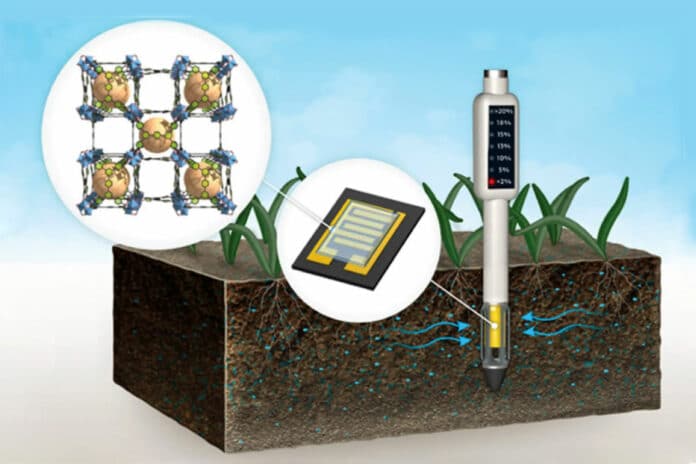The ongoing global industrialization, along with the notable world population growth, is projected to challenge the global environment as well as pose greater pressure on water and food needs.
Foreseeably, an improved irrigation management system in agriculture is one of the most effective tools to protect precious water resources, especially in arid and desert regions of the globe. Also, the quest for refined chemical sensors for soil-moisture monitoring is of tremendous importance.
A research team at King Abdullah University of Science and Technology (KAUST) in Saudi Arabia has developed a rapid and sensitive soil moisture sensor based on a metal-organic framework (MOF) with a very high affinity for water. Soil-moisture monitoring sensors can help farmers save water by letting them know when their crops really need to be watered.
MOFs are highly porous synthetic materials with a cage-like internal structure that can be adapted to host certain small molecules, including water.
“With their modular porous structure and easy functionalization, MOFs are excellent candidates for sensing applications,” says Osama Shekhah, a research scientist in the team led by Mohamed Eddaoudi along with Khaled Salama. “MOF thin films have already been incorporated into electronic devices, paving the way for their translation to real-world use.”
The KAUST team tested several different MOFs, including the highly porous Cr-soc-MOF-1, which can capture twice its own weight in water. Researchers say the Cr-soc-MOF-1 offers the best sensitivity for any given range of soil-moisture content, outperforming several well-known oxide materials.
The researchers coated the MOFs onto an inexpensive interdigitated electrode microsensor that can be fabricated by inkjet printing or laser etching. The sensor was then inserted into moist soil. As the film proceeded to draw water in from the soil, that water displaced some of the air in the MOF, altering its electrical capacitance, a process that can be detected and measured.
Each MOF device was tested in clayey and in loamy sand soil types, which can show significant differences in texture and water-holding capacity. “Notably, the Cr-soc-MOF-1-coated soil-moisture sensor showed the highest sensitivity, of about 450 percent in clayey soil, with a response time of around 500 seconds,” Salama says.
The sensor’s response was highly selective for water, even when various metal ions were present in the soil.
“We are now designing and developing a portable prototype MOF-based soil moisture sensor that can be easily used for control experiments in real-world, in-field measurements,” Eddaoudi says. “We anticipate that MOF-based soil-moisture sensors will advance the next-generation soil-moisture sensor technology, offering automated and precise irrigation systems,” Salama adds.
Journal reference:
- Norah Alsadun, Sandeep Surya, Kamlesh Patle, Vinay S. Palaparthy, Osama Shekhah, Khaled N. Salama, and Mohamed Eddaoudi. Institution of Metal-Organic Frameworks as a Highly Sensitive and Selective Layer In-Field Integrated Soil-Moisture Capacitive Sensor. American Chemical Society, 2023; DOI: 10.1021/acsami.2c20141
